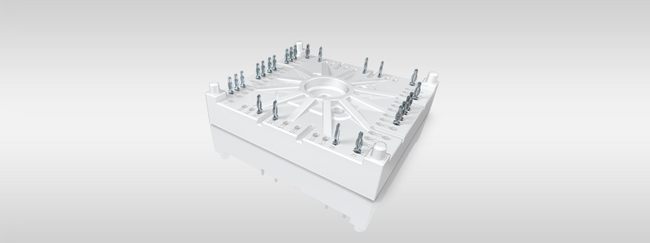Solder bond power semiconductor modules cover a voltage range from 55V to 6500V with current from 1A to 3600A. There are almost all known topologies, such as half-bridges, sixpacks, and even CIB Converter – Inverter – Brake modules in which the functions of a rectifier, inverter, and brake chopper are integrated into one housing.
A significant share of solder bond modules is presented by intelligent power modules with a built-in driver and temperature and current sensors. With such a large range of devices, various design technologies are used to manufacture solder bond power modules. Power modules built using the leadframe technology are widely used in the production of discrete devices in plastic housing.
The holder of the IGBT chips and the driver chip is a stamped copper strip. The module body is molded by filling with epoxy resin, which also serves as protection from the environment. To provide an electrically insulated heatsink, the frame is mounted on an insulated aluminum or copper similar to the baseplate, and then is being filled. Typical voltages of such modules are 600-1200V, with currents from 1A to 30A.
High current small size solder bond modules are assembled in a constructive design such as Infineon’s Easy or Semikron’s SEMITOP. These are very similar designs with the traditional assembly and wiring of chips, and a multi-pin system. The external terminals facilitate the integration of the module with the control board, and also make it possible to implement a variety of circuit diagrams for connecting active semiconductor elements inside the module up to a complete power unit with current and temperature sensors, as well as an integrated driver.
Standard solder bond power semiconductor modules are designed for the implementation of simple circuit configurations. A series of high voltage modules essentially repeats the standard series, but some changes are made to their design that are necessary for use at a higher voltage.
The basic design and technological concept for all the types of solder bond power semiconductor modules is the same, i.e., DBCs are soldered onto a massive and mechanically strong heat-conducting baseplate (usually copper, but various composites have been intensively used in recent years), which, in turn, are soldered with semiconductor chips.
Wiring from the upper contact pads of the chips to the contact pads of the board is carried out by aluminum, the external terminals are soldered or welded. Protection of the chips from the influence of the external environment is carried out by pouring a compound, the outer plastic housing is mechanically strong but not sealed.
There are modules with increased environmental resistance, and they can be divided into two groups. First, these are modules in quasi-hermetic plastic housing. According to their basic design and technological concept, these modules correspond to the traditional solder bond types. However, such modules are packaged with a special plastic that forms dense, almost sealed, and resistant to humidity. Secondly, these are the modules in sealed metal-glass or metal-ceramic housings.
Learn more about power semiconductors in Power Semiconductors section of my Marketing Psycho blog. And if you are interested in power semiconductors market news, you can always subscribe to my Power Semiconductors Weekly updates.
Power Semiconductors Weekly is a Marketing Psycho weekly podcast covering the latest news from power semiconductors industry. Delivered to you every Tuesday by Alexey Cherkasov, Power Semiconductors Weekly brings you the most interesting events in the world of power semiconductors and power electronics. Subscribe to Power Semiconductors Weekly and watch it on YouTube every Tuesday.
If you prefer a monthly update about the world of power semiconductors delivered to your e-mail address, please, subscribe to Marketing Psycho Power Semiconductors newsletter.

